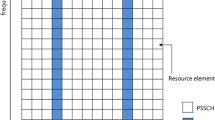Abstract
DS-CDMA is recognised as one of the foremost mobile radio access techniques today. However, to date, there has been scant information on the system implementation and the many problems facing radio engineers. In this contribution, the design of the downlink (base to mobile) for a wideband (8.192Mchips/sec) DS-CDMA air interface is described along with practical results gained from its successful implementation in a full DS-CDMA system demonstrator developed under the U.K. DTI/EPSRC LINK programme. The aim is to provide a practical insight into CDMA and its application as a candidate for future personal communication systems. Synchronisation was one of the major challenges with the downlink and the techniques developed as part of this work are described fully.
Similar content being viewed by others
References
K.S. Gilhousen et al., “On the Capacity of a Cellular CDMA System”, IEEE Trans. on Veh. Tech., Vol. 40, No.2, May 1991, pp. 303–312.
“RACE Mobile Telecommunications Summit”, XIIIB4166/ 95, Cascais, Portugal, Nov. 1995
M.A. Beach (Chapter Editor), A CDMA Air Interface for Mobile Access, Chapter 7.2 in Digital Mobile Radio (E. Damosso, Editor), Springer, ISBN 3–540-76038-5, 1997.
S.C. Swales, T. Busby, D.J. Purle and M.A. Beach, “AComparison of CDMA Techniques for Third Generation Mobile Radio Systems”, 43rd IEEE Veh. Tech. Conf., New Jersey, USA, May 1993, pp. 424–427.
J.P. Aldis, A.H. Kemp and S.K. Barton, “The Engineering of a DS-CDMA Reverse Link for a Mobile Radio Demonstration System”, Accepted for publication in IEE Proceedings on Communications (1997).
S.A. Allpress, “Optimising Signalling Rate and Internal Diversity Order for Mobile Cellular DS-CDMA Systems”, Ph.D Thesis, Department of Electrical and Electronic Engineering, University of Bristol, Dec. 1993.
A.H.M. Ross and K.S. Gilhousen, “CDMA Technology and the IS95 North American Standard”, in ‘Mobile Communications Handbook’, CRC Press, 1996, ISBN 0–8493-8573-3, pp. 430–448.
R.S. Mowbray and P.M. Grant, “Wideband Coding for Uncoordinated Multiple Access Communication”, IEE Electronics and Communication Engineering Journal, Vol. 4, No.6, Dec. 1992, pp. 351–361.
G.L. Turin, “Introduction to Spread Spectrum Anti-Multipath Techniques and Their Application to Urban Digital Radio”, Proc. IEEE, Vol. 68, March 1980, pp. 328–343.
R.E. Best, “Phase-Locked Loops”, McGraw Hill, 1982, pp. 212–217.
W.P. Robins, “Phase Noise in Signal Sources”, Peter Peregrinus Ltd, IEE Telecommunications Series 9, 1982, pp. 130–31.
D.B. Chester and G. Phillips, “Single Chip Digital Downconverter Simplifies RF DSP Applications”, RF Design, Nov. 1992, pp. 39–46.
F.M. Gardner, “Phaselock Techniques”, Wiley, 1979, Chapter 2.
A. Bateman and W. Yates, “Digital Signal Processing Design”, Pitman, 1988, Chapter 4.
T. Mäkeläinen et al., “FRAMES Demonstration Implementation Roadmap”, ACTS Mobile Telecommunication Summit, Granada, Spain, 27–29th November 1996, Vol 1, pp. 104–108.
Author information
Authors and Affiliations
Rights and permissions
About this article
Cite this article
Swales, S., Busby, T., Beach, M. et al. Downlink Design for a Wideband DS-CDMA Demonstrator. Wireless Personal Communications 7, 275–301 (1998). https://doi.org/10.1023/A:1008823931632
Issue Date:
DOI: https://doi.org/10.1023/A:1008823931632




